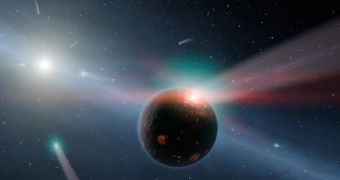Some of the most interesting directions of research in astronomy include the discovery of extrasolar moons. But scientists say that finding extrasolar rings may also prove helpful in our quest for potentially-habitable ecosystems in space.
Astronomers know that exorings exist around distant worlds simply because gas giants have been identified in other star systems. Additionally, all planetary formation mechanisms are the same throughout the Universe, so the existence of gas giants implies dust and ice rings are present, too.
Experts proposed looking for exorings as far back as 2004, but observations technologies at the time were not nearly as advanced as they are today, so the quest was doomed from the start. However, theoreticians did provide some insight into how such observations could be conducted.
The main conclusion was that the photometric precision of telescopes should be less than one part in ten-thousand, a requirement that is more than met by the NASA Kepler Telescope today, as well as other observatories.
Even so, exorings could theoretically be detected only if they are placed face-on, rather than edge-on. If similar structures in our own solar system are any indication, then the rings around distant gas giants would be only several meters in thickness.
This would make it impossible for even Kepler to see them. In a study authored this year by Schlichting & Chang et al., researchers indicated warped rings may also be a possibility around exoplanets. The effect would arise if the planetary spin and its plane of orbit would be aligned.
Scientists also propose using established exoplanetary research missions like CoRoT and Kepler to look for exorings. This could be achieved by scanning their extensive datasets for light curves that may be indicative to the presence of planetary rings.
It is currently believed that theoretical computer models could be used to simulate the light curve of a planetary ring far away from Earth. While creating the simulation itself is not difficult, testing it against empirical data certainly is.
One of the potential obstacles to using this observations technique correctly is mistaking the light curve generated by another planet as coming from potential rings against whichever object astronomers are studying. Teasing out which is which will be a very complex process, Universe Today reports.

 14 DAY TRIAL //
14 DAY TRIAL //